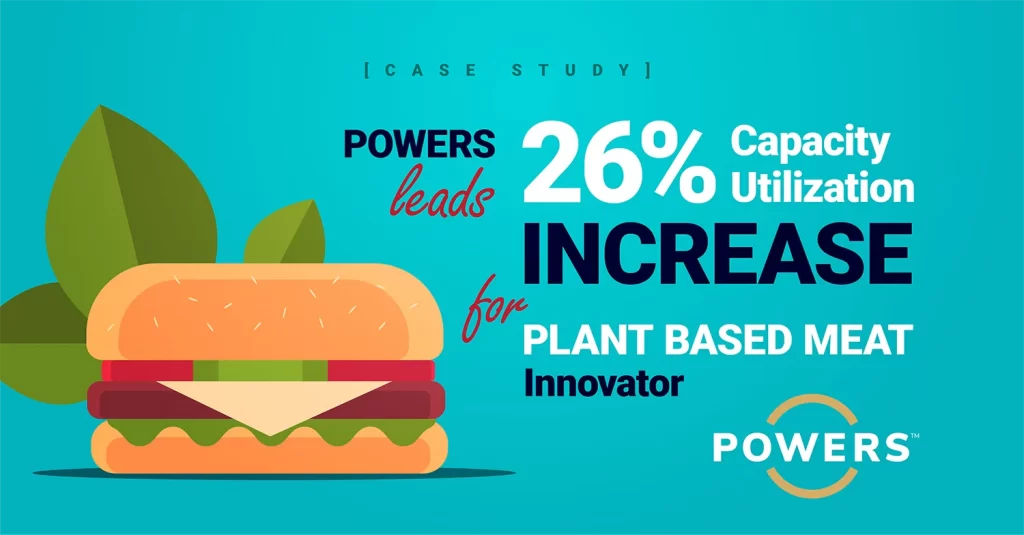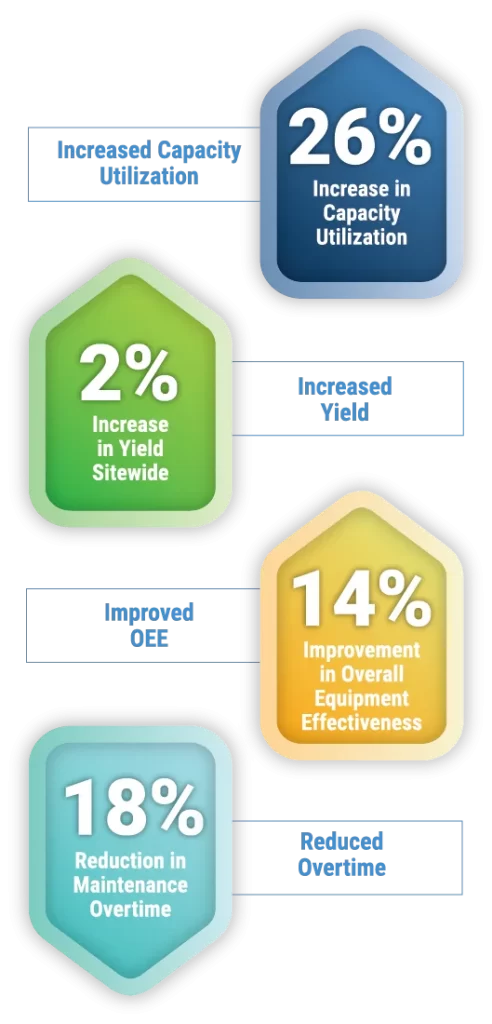
Beyond the existing systems, processes, and cultural issues at the newly-acquired site, the changes from the acquisition itself, and our client’s intense growth compounded the capacity utilization challenges.

Project Overview

Performance Results
Recently, a disruptor and innovator in plant-based meat products for the retail and foodservice sectors partnered with POWERS to turn around flagging capacity utilization at a newly acquired site.
They aimed to transition the leadership team, labor force, systems, and processes to their own methods and drastically improve the site’s production, which stood at a lackluster 46% capacity utilization.
Our client’s acquisition of the “mom & pop shop” came with the entire labor and management workforce. Unfortunately, the existing leadership and workforce culture was out of step with new ownership and lagged significantly behind industry standards for operational excellence.
From a Culture Performance Management perspective, we found engagement on the shop floor to be minimal, expectations poorly communicated, inadequate training, and leadership struggling to come together as a team to solve issues. The site leadership struggled to develop a “one team” approach to problem-solving.
Operationally, the site suffered from:
- No MOS (Management Operating System)
- No formalized processes for production, maintenance, logistics, and commercialization.
- Lack of objective data fueling unproductive decision-making.
- High labor turnover
- Lack of leadership, operator, and mechanical skills training
- Massive product waste
- Poorly managed materials and ingredients for on-demand production
- An “emergency” maintenance culture through poor supervision, scheduling, and prioritizing
Beyond the existing systems, processes, and cultural issues, the changes from the acquisition itself and our client’s intense growth compounded the challenges.

Project Overview
Recently, a disruptor and innovator in plant-based meat products for the retail and foodservice sectors partnered with POWERS to turn around flagging capacity utilization at a newly acquired site. They aimed to transition the leadership team, labor force, systems, and processes to their own methods and drastically improve the site’s production, which stood at a lackluster 46% capacity utilization.
Our Partner’s acquisition of the “mom & pop shop” came with the entire labor and management force. Unfortunately, the existing leadership and workforce culture was out of step with new ownership and lagged significantly behind industry standards for operational excellence.
From a Culture Performance Management perspective, we found engagement on the shop floor to be minimal, expectations poorly communicated, inadequate training, and leadership struggling to come together as a team to solve issues. The site leadership struggled to develop a “one team” approach to problem-solving.
Operationally, the site suffered from:
- No MOS (Management Operating System)
- No formalized processes for production, maintenance, logistics, and commercialization.
- Lack of objective data fueling unproductive decision-making.
- High labor turnover
- Lack of leadership, operator, and mechanical skills training
- Massive product waste
- Poorly managed materials and ingredients for on-demand production
- An “emergency” maintenance culture through poor supervision, scheduling, and prioritizing
Beyond the existing systems, processes, and cultural issues, the changes from the acquisition itself and our Partner’s intense growth compounded the challenges.
Our Approach
- Full MOS implementation in Production, Maintenance, Warehousing, and Commercialization
- Facilitate our Workforce Engagement (WE) Workshops to connect optimized manufacturing processes and frontline leadership behavior
- Develop Batching Area, Maintenance RFQ, and Commercialization Trial process flows
- Implement Downtime Tracking, Yield Tracking, and OEE% so the team could make specific action plans around objective data
Performance Results
- 26% Improvement in Capacity Utilization
- 2% Increase in Yield
- 14% Improvement in OEE (Overall Equipment Effectiveness)
- 18% Reduction in Maintenance Overtime
- 10% Improvement in Maintenance Mechanic Utilization
- 5% Improvement in Maintenance Mechanic Load
- Fully implemented Production, Maintenance, Warehousing, and Commercialization MOS
- Maintenance planning and scheduling began assigning work to technicians daily
- Equipped managers with the tools and data needed to manage their areas to capacity
- Developed and implemented processes to control the flow and reduce errors and rework
- Trained leadership team on proper line balancing to increase capacity





